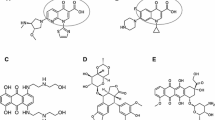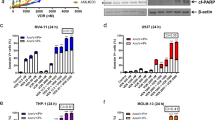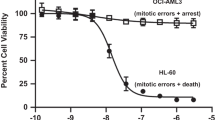Abstract
Main purpose
Voreloxin is a first-in-class anticancer quinolone derivative that intercalates DNA and inhibits topoisomerase II, inducing site-selective DNA damage. Voreloxin is in clinical studies, as a single agent and in combination with cytarabine, for the treatment of acute myeloid leukemia (AML). The preclinical studies reported here were performed to investigate the activity of voreloxin alone and in combination with cytarabine, in support of the clinical program.
Research questions
Is single agent voreloxin active in preclinical models of AML? Does the combination of voreloxin and cytarabine enhance the activity of either agent alone?
Methods
Inhibition of proliferation was studied in three cancer cell lines: HL-60 (acute promyelocytic leukemia), MV4-11 (AML), and CCRF-CEM (Acute lymphoblastic leukemia). Combination index (CI) analysis established the effect of the drugs in combination. A mouse model of bone marrow ablation was used to investigate in vivo efficacy of the drugs alone and in combination. Peripheral white blood cell and platelet counts were followed to assess marrow impact and recovery.
Results
Voreloxin and cytarabine alone and in combination exhibited cytotoxic activity in human leukemia cell lines and in vivo. The two drugs had additive or synergistic activity in vitro and supra-additive activity in vivo. Bone marrow ablation was accompanied by reductions in peripheral white blood cells and platelets that were reversible within 1 week, consistent with the AML treatment paradigm.
Conclusions
These data support ongoing clinical evaluation of voreloxin both alone and in combination with cytarabine for the treatment of AML.




Similar content being viewed by others
References
Advani RH, Hurwitz HI, Gordon MS, Ebbinghaus SW, Mendelson DS, Wakelee HA, Hoch U, Silverman JA, Havrilla NA, Berman CJ, Fox JA, Allen RS, DC A (2009) Phase 1 Experience with Voreloxin, a First in Class Anticancer Quinolone Derivative, in Relapsed/Refractory Solid Tumors: A report on two dosing schedules (Submitted)
Alberts DS, Bachur NR, Holtzman JL (1971) The pharmacokinetics of daunomycin in man. Clin Pharmacol Ther 12:96–104
Burke PJ, Karp JE, Vaughan WP (1981) Chemotherapy of leukemia in mice, rats, and humans relating time of humoral stimulation, tumor growth, and clinical response. J Natl Cancer Inst 67:529–538
Capranico G, De Isabella P, Penco S, Tinelli S, Zunino F (1989) Role of DNA breakage in cytotoxicity of doxorubicin, 9-deoxydoxorubicin, and 4-demethyl-6-deoxydoxorubicin in Murine Leukemia P388 cells. Cancer Res 49:2022–2027
Chou TC (2006) Theoretical basis, experimental design, and computerized simulation of synergism and antagonism in drug combination studies. Pharmacol Rev 58:621–681
Chou TC, Talaly P (1977) A simple generalized equation for the analysis of multiple inhibitions of Michaelis-Menten kinetic systems. J Biol Chem 252:6438–6442
Del Poeta G, Stasi R, Aronica G, Venditti A, Cox M, Bruno A, Buccisano F, Masi M, Tribalto M, Amadori S, Papa G (1996) Clinical relevance of P-glycoprotein expression in de novo acute myeloid leukemia. Blood 87:1997–2004
Evanchik MJ, Allen D, Yoburn JC, Silverman JA, Hoch U (2009) Metabolism of (+)-1, 4-dihydro-7-(trans-3-methoxy-4-methylamino-1-pyrrolidinyl)-4-oxo-1-(2-thiazolyl)-1, 8-naphthyridine-3-carboxylic acid (voreloxin; formerly SNS-595), a novel replication-dependent DNA-damaging agent. Drug Metab Dispos 37:594–601
Everds N (2004) Hematology of the Mouse. In: Hedrich H (ed) The Laboratory Mouse. Elsevier Academic Press, Amsterdam
Fliedner TM, Graessle D, Paulsen C, Reimers K (2002) Structure and function of bone marrow hemopoiesis: mechanisms of response to ionizing radiation exposure. Cancer Biother Radiopharm 17:405–426
Gilliland DG, Griffin JD (2002) The roles of FLT3 in hematopoiesis and leukemia. Blood 100:1532–1542
Hawtin RE, Stockett DE, Byl JA, McDowell RS, Tan N, Arkin MR, Wang W, Conroy A, Osheroff N, J.A. F (2009) Voreloxin is an anticancer quinolone derivative that intercalates DNA and poisons topoisomerase II
Hirte H, McGuire W, Edwards R, Husain A, Hoskins P, Michels J, Matulonis U, Sexton C, Mahadocon K, Fox J, Michelson G (2009) A phase 2 trial of voreloxin in women with platinum-resistant ovarian cancer. In: Proceedings, American Society of Clinical Oncology (ASCO) annual meeting
Hoch U, Lynch J, Sato Y, Kashimoto S, Kajikawa F, Furutani Y, Silverman J (2009) Voreloxin, formerly SNS-595, has potent activity against a broad panel of cancer cell lines and in vivo tumor models. Cancer Chemother Pharmacol 64:53–65
Jaenke RS, Deprez-DeCampeneere D, Trouet A (1980) Cardiotoxicity and comparative pharmacokinetics of six anthracyclines in the rabbit. Cancer Res 40:3530–3536
Kufe DW, Major PP, Egan EM, Beardsley GP (1980) Correlation of cytotoxicity with incorporation of ara-C into DNA. J Biol Chem 255:8997–9000
Kufe DW, Munroe D, Herrick D, Egan E, Spriggs D (1984) Effects of 1-beta-D-arabinofuranosylcytosine incorporation on eukaryotic DNA template function. Mol Pharmacol 26:128–134
Lancet J (2009) Phase Ib/II pharmacokinetic/pharmacodynamic (PK/PD) study of combination voreloxin and cytarabine in relapsed or refractory AML patients. In: Proceedings, American Society of Clinical Oncology (ASCO) annual meeting
Lapidot T, Dar A, Kollet O (2005) How do stem cells find their way home? Blood 106:1901–1910
Levis M, Pham R, Smith BD, Small D (2004) In vitro studies of a FLT3 inhibitor combined with chemotherapy: sequence of administration is important to achieve synergistic cytotoxic effects. Blood 104:1145–1150
List AF (1996) Role of multidrug resistance and its pharmacological modulation in acute myeloid leukemia. Leukemia 10:937–942
Matsukage A, Ono K, Ohashi A, Takahashi T, Nakayama C, Saneyoshi M (1978) Inhibitory effect of 1-beta-D-arabinofuranosylthymine 5’-triphosphate and 1-beta-D-arabinofuranosylcytosine 5’-triphosphate on DNA polymerases from murine cells and oncornavirus. Cancer Res 38:3076–3079
Moore J, Nivison-Smith I, Goh K, Ma D, Bradstock K, Szer J, Durrant S, Schwarer A, Bardy P, Herrmann R, Dodds A (2007) Equivalent survival for sibling and unrelated donor allogeneic stem cell transplantation for acute myelogenous leukemia. Biol Blood Marrow Transplant 13:601–607
Nielsen D, Maare C, Skovsgaard T (1996) Cellular resistance to anthracyclines. Gen Pharmacol 27:251–255
Ravandi F, Stuart R, Maris M, Stone R, Cripe R, Cooper M, Strickland S, Turturro F, Stock W, Mahadocon K, Fox J, Michelson G, Berman C (2009) A phase II study of voreloxin as single agent therapy for elderly patients (pts) with newly diagnosed acute myeloid leukemia (AML). American Society of Clinical Oncology (ASCO) Annual Meeting
Reynolds CP, Maurer BJ (2005) Evaluating response to antineoplastic drug combinations in tissue culture models. Methods Mol Med 110:173–183
Speth PA, Linssen PC, Boezeman JB, Wessels HM, Haanen C (1987) Leukemic cell and plasma daunomycin concentrations after bolus injection and 72 h infusion. Cancer Chemother Pharmacol 20:311–315
Stone RM, O’Donnell MR, Sekeres MA (2004) Acute Myeloid Leukemia: ASH education Hematology: 98–117
Tallman MS, Gilliland DG, Rowe JM (2005) Drug therapy for acute myeloid leukemia. Blood 106:1154–1163
Wong R, Giralt SA, Martin T, Couriel DR, Anagnostopoulos A, Hosing C, Andersson BS, Cano P, Shahjahan M, Ippoliti C, Estey EH, McMannis J, Gajewski JL, Champlin RE, de Lima M (2003) Reduced-intensity conditioning for unrelated donor hematopoietic stem cell transplantation as treatment for myeloid malignancies in patients older than 55 years. Blood 102:3052–3059
Zhao L, Wientjes MG, Au JL (2004) Evaluation of combination chemotherapy: integration of nonlinear regression, curve shift, isobologram, and combination index analyses. Clin Cancer Res 10:7994–8004
Zittoun J, Marquet J, David JC (1991) Mechanism of inhibition of DNA ligase in Ara-C treated cells. Leuk Res 15:157–164
Zittoun J, Marquet J, David JC, Maniey D, Zittoun R (1989) A study of the mechanisms of cytotoxicity of Ara-C on three human leukemic cell lines. Cancer Chemother Pharmacol 24:251–255
Acknowledgments
The authors would like to thank Dr. Carl L. Millward and Dr. Lisa H. Tai for pathology review, Aaron McCarty and his staff for animal husbandry support.
Conflict of interest statement
All authors are current or former employees of Sunesis Pharmaceuticals. The research was funded by Sunesis Pharmaceuticals.
Author information
Authors and Affiliations
Corresponding author
Additional information
Authors have full control of all primary data and agree to allow the journal to review their data if requested.
Rights and permissions
About this article
Cite this article
Scatena, C.D., Kumer, J.L., Arbitrario, J.P. et al. Voreloxin, a first-in-class anticancer quinolone derivative, acts synergistically with cytarabine in vitro and induces bone marrow aplasia in vivo. Cancer Chemother Pharmacol 66, 881–888 (2010). https://doi.org/10.1007/s00280-009-1234-z
Received:
Accepted:
Published:
Issue Date:
DOI: https://doi.org/10.1007/s00280-009-1234-z




